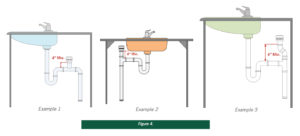
CodeNotes: Installation of air admittance valves
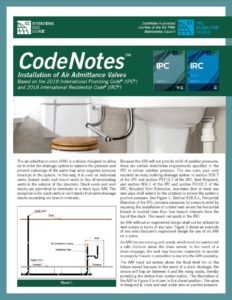 Air admittance valves are devices that were created to solve a problem with the conventional open pipe venting design and can serve as a vent for drainage waste and vent systems in lieu of open pipe vents. This CodeNotes — Installation of Air Admittance Valves [based on the 2018 International Plumbing Code (IPC) and 2018 International Residential Code (IRC)] — provides an understanding of the IPC and IRC requirements on the installation of these valves.
Air admittance valves are devices that were created to solve a problem with the conventional open pipe venting design and can serve as a vent for drainage waste and vent systems in lieu of open pipe vents. This CodeNotes — Installation of Air Admittance Valves [based on the 2018 International Plumbing Code (IPC) and 2018 International Residential Code (IRC)] — provides an understanding of the IPC and IRC requirements on the installation of these valves.
Developed in Sweden in the early 1970’s, the air admittance valve was later introduced into the United States about 1986. Millions of these valves have been installed, which has led to significant cost savings. The primary benefit from the use of the air admittance valve is realized in the reduction of construction costs for the drainage system. When each plumbing fixture trap is no longer required to have its own vent pipe through the building roof, major savings can be realized. Further, aesthetic benefits derive from the elimination of multiple roof vent outlets, and the risk of roof leakage through pipe openings is also reduced.
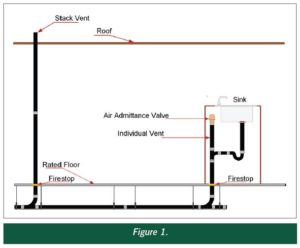 The air admittance valve (AAV) is a device designed to allow air to enter the drainage system to balance the pressure and prevent siphonage of the water trap when negative pressure develops in the system. In this way, it is used on individual vents, branch vents and circuit vents in lieu of terminating vents to the exterior of the structure. Stack vents and vent stacks are permitted to terminate to a stack type AAV. The exception is for stack vents or vent stacks that serve drainage stacks exceeding six branch intervals.
The air admittance valve (AAV) is a device designed to allow air to enter the drainage system to balance the pressure and prevent siphonage of the water trap when negative pressure develops in the system. In this way, it is used on individual vents, branch vents and circuit vents in lieu of terminating vents to the exterior of the structure. Stack vents and vent stacks are permitted to terminate to a stack type AAV. The exception is for stack vents or vent stacks that serve drainage stacks exceeding six branch intervals.
Because the AAV will not provide relief of positive pressures, there are certain installation requirements specified in the International Plumbing Code (IPC) to relieve positive pressure. The one open pipe vent required on every building drainage system in section 918.7 of the IPC and section P3114.7 of the International Residential Code (IRC), Vent Required, and section 904.1 of the IPC and section P3102.1 of the IRC, Required Vent Extension, mandates that at least one vent pipe shall extend to the outdoors to relieve the system’s positive pressure. See Figure 1. Section 918.3.1, Horizontal Branches of the IPC, contains measures for pressure relief by requiring the installation of a relief vent where the horizontal branch is located more than four branch intervals from the top of the stack. This would not apply in the IRC.
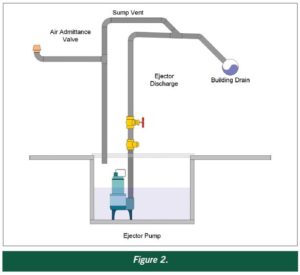 An AAV without an engineered design shall not be utilized to vent sumps or tanks of any type. Figure 2 shows an example of one manufacturer’s engineered design for use of an AAV on a sump.
An AAV without an engineered design shall not be utilized to vent sumps or tanks of any type. Figure 2 shows an example of one manufacturer’s engineered design for use of an AAV on a sump.
An AAV has one moving part, a seal, which must be maintained a safe distance above the drain served. In the event of a drain stoppage, the seal may become inoperable or operate improperly if waste is permitted to rise into the AAV assembly.
The AAV need not extend above the flood level rim of the fixture served because in the event of a drain blockage, the device will trap air between it and the rising waste, thereby protecting the device from contamination. The illustration of the AAV in Figure 3 is shown in the closed position. The valve is designed to close and seal under zero or positive pressure.
Air Admittance Valve in Branch Applications (ASSE 1051)
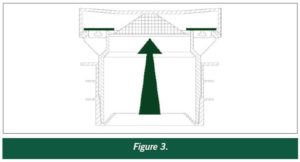 In the IPC, AAVs shall be installed in accordance with the requirements of section 918 and the manufacturers instruction. The AAVs shall be installed after the DWV testing required by Section 312.2 or 312.3 has been performed. The IRC requires AAVs be installed in accordance with section P3114 and the manufacturers instruction. The AAVs shall be installed after the DWV testing required by Section P2503.5.1 or P2503.5.2 has been performed.
In the IPC, AAVs shall be installed in accordance with the requirements of section 918 and the manufacturers instruction. The AAVs shall be installed after the DWV testing required by Section 312.2 or 312.3 has been performed. The IRC requires AAVs be installed in accordance with section P3114 and the manufacturers instruction. The AAVs shall be installed after the DWV testing required by Section P2503.5.1 or P2503.5.2 has been performed.
Individual and branch-type AAVs shall not be located not less than 4 inches (102 mm) above the horizontal branch drain or fixture drain being vented. See Figure 4, Examples 1, 2 and 3.
AAVs shall be accessible, should replacement be required. Such valves shall be installed in a location that allows air to enter the valve. Locating the valve in a sink or vanity cabinet is accessible. For in wall installation, use a recess box/grill combination or access grill. See Figure 5.
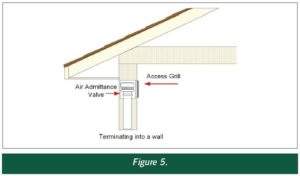
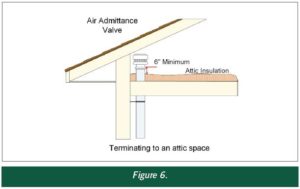
The AAV shall be installed not less than 6 inches (152 mm) above insulation material. See Figure 6.
Air Admittance Valve in a Stack Application (ASSE 1050)
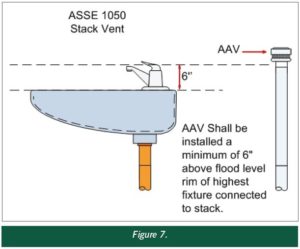 The stack-type AAV shall be located not less than 6 inches (152 mm) above the flood level rim of the highest fixture being vented. The AAV shall be located within the maximum developed length permitted for the vent. See Figure 7.
The stack-type AAV shall be located not less than 6 inches (152 mm) above the flood level rim of the highest fixture being vented. The AAV shall be located within the maximum developed length permitted for the vent. See Figure 7.
AAVs shall be accessible, should replacement be required. Such valves shall be installed in a location that allows air to enter the valve. The AAV shall be installed not less than 6 inches (152 mm) above insulation materials that may block air inlets or otherwise impair the operation of the device.
In summarizing, the installation of AAVs must conform to the requirements of section 918 of the IPC, Air Admittance Valves, or section P3113 of the IRC, Vent Pipe Sizing, and the manufacturers instruction. Where differences occur between the provisions of the code and the manufacturer instructions, the most restrictive provisions must apply.
To learn more about the code requirements for the installation of AAVs, please refer to the 2018 IPC Code and Commentary, and the 2018 IRC Code and Commentary.
As part of its goal to serve the needs of plumbing, mechanical and fuel gas (PMG) officials, the ICC PMG Official Membership Council is committed to providing free, informative code support documents known as CodesNotes that can be used to complement building departments’ in-house weekly supplemental training. We hope you enjoy this newest edition of CodeNotes. Past topics include backflow devices and the protection of the water supply, gas pipe sizing based on the latest edition of the International Fuel Gas Code and the International Residential Code, and bonding of corrugated stainless steel tubing gas piping systems, just to name a few. The CodesNotes collection has recently been expanded to include a selection of notes offered in Spanish.
The ICC PMG Official Membership Council website offers many resources. The council — open to all ICC members and serving the needs of PMG officials and industry professionals — consists of a great team of professionals who are willing to share their technical expertise and experiences. You’ll have the opportunity to discuss issues that you face as a community, and how ICC might best serve you. If you haven’t already done so, please go online and become a member of the PMG Official Membership Council.

TDBRQfRygFlNgQ44lgJuHWQbi0T7bvk7IVb6gvQqb-E=.html
